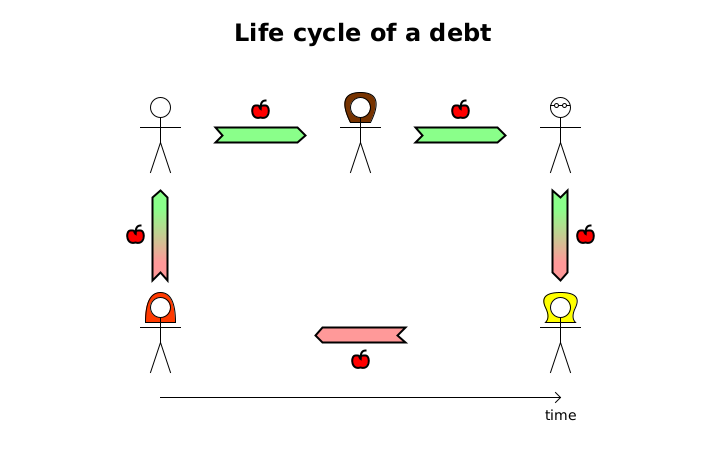Now that we’ve looked at the real economy (goods and services) and the financial economy (debts), the whole economy is just the two put together.
There are tangible assets. Each one which has been produced and not yet consumed is added to the raw net worth1 of the current owner (in a chain of owners from producer to consumer).
And there are debts. Each one which has been created and not yet written off increases the RNW of the current creditor (in the top row of a debt loop), and decreases the RNW of the current debtor (in the bottom row of a debt loop) by the same amount.
And that’s it! Every economic action which has ever existed or will ever exist belongs to exactly one of these chains or loops.
Each person’s RNW is:
The sum of all the tangible assets for which they are the current owner;
PLUS the sum of all debts for which they are the current creditor;
MINUS the sum of all debts for which they are the current debtor.
Any physicists and engineers will probably recognise that the state of the economy is simply the superposition of the states of each of the chains and loops, and understand how remarkably powerful this is for understanding economics. And that is the essence of the One Lesson:
Typically, economic activity consists of transactions where two (or more) people transfer some of their RNW to someone else, and receive some of someone else’s RNW. At other times, RNW is simply transferred with nothing given in return (e.g. a gift or theft).
Almost barter
In essence, what we have is something very similar to a barter system, but instead of people simply producing, transferring, exchanging and consuming goods and services, they are producing, transferring, exchanging and consuming RNW. The only major difference in the workings of an economy with debts compared to barter is that some debts are defaulted, and so what was believed to have been an exchange in the past could turn out to have really been transfer, or what was believed to have been a transfer in the past could turn out to have had no effect whatsoever.
The whole global economy with all of its billions of people, trillions (or more) of transactions per year, multiple currencies, and complex financial instruments is simply made up of these chains and loops, which are individually easy to understand, and which just need to be added together to find the state of the whole economy.
If you’ve followed from the beginning last May, you now should have a pretty good understanding of the whole economy, and be able to see when people who explain their theories of economics to you are mistaken or even trying to deceive you.
You’re welcome!
If you have any questions, or suggestions for future articles, please do leave a comment.
Someone’s raw net worth (RNW) is what they own plus what they’re owed minus what they owe. It is a “heterogeneous” sum/difference, which just means that things of different types are added and subtracted, not monetary “values” which have been assigned to them.






